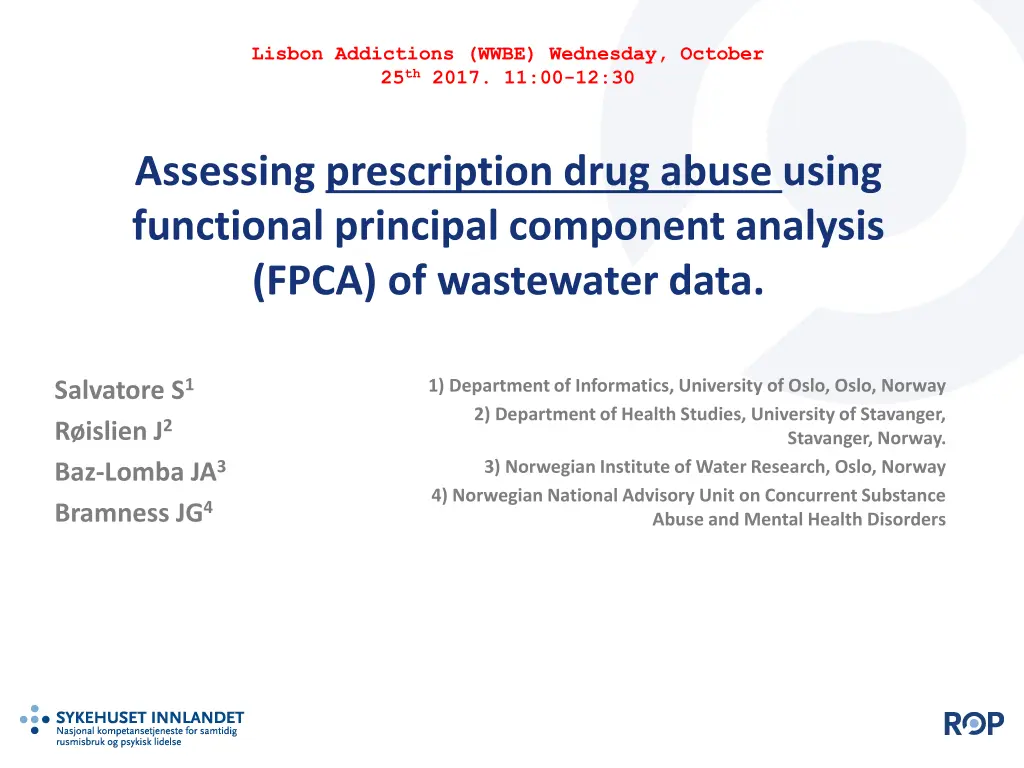
Assessment of Prescription Drug Abuse Using Wastewater Data
Explore a study on using functional principal component analysis of wastewater data to assess prescription drug abuse trends. The research focuses on temporal variations of drugs like methadone and methylphenidate, aiming to characterize abuse patterns through advanced statistical methods.
Download Presentation

Please find below an Image/Link to download the presentation.
The content on the website is provided AS IS for your information and personal use only. It may not be sold, licensed, or shared on other websites without obtaining consent from the author. If you encounter any issues during the download, it is possible that the publisher has removed the file from their server.
You are allowed to download the files provided on this website for personal or commercial use, subject to the condition that they are used lawfully. All files are the property of their respective owners.
The content on the website is provided AS IS for your information and personal use only. It may not be sold, licensed, or shared on other websites without obtaining consent from the author.
E N D
Presentation Transcript
Lisbon Addictions (WWBE) Wednesday, October 25th 2017. 11:00-12:30 Assessing prescription drug abuse using functional principal component analysis (FPCA) of wastewater data. Salvatore S1 R islien J2 Baz-Lomba JA3 Bramness JG4 1) Department of Informatics, University of Oslo, Oslo, Norway 2) Department of Health Studies, University of Stavanger, Stavanger, Norway. 3) Norwegian Institute of Water Research, Oslo, Norway 4) Norwegian National Advisory Unit on Concurrent Substance Abuse and Mental Health Disorders
Background The abuse of prescription drugs/medicinal drugs is an increasing problem Definitely in US Maybe also in Europe Monitoring: all data sources have their problems Reporting/recall bias (illegal, amnesia) Selection bias (who answers, black market) Monitoring: could waste water data be an option? Spatial differences (where are drugs used in excess?) What could we get out of temporal differences?
What's been done in WWBE? Salvatore and Bramness 2015 (unpublished data)
Spatial variation (EMCDDA web-site)
Temporal variation Zuccato et al 2008 Different drugs are abused differently and behave differently in the sewer Are there more sophisticated methods for investigating weekend peak?
AIM Can the known weekly temporal variations for drugs of abuse be used to characterise prescription drugs of abuse? Methadone Methylphenidate Can more advanced statistical methods be used? Methylphenidate and methadone were chosen because They were measured They have less well known black market than e.g. benzodiazepines They are not metabolically related to other drugs
Materials and methods Sewage samples February 2014 Oslo, Norway. The weekly pattern of each drug Extracted by fitting of generalized additive models (GAM), Trigonometric functions to model the cyclic behavior The weekly component: main temporal features extracted by functional principal component (FPC) analysis We get FPCs and corresponding FPC scores.
MEDICINAL DRUGS OF ABUSE? Oxazepam Methadone Methylphenidate KNOWN DRUGS OF ABUSE (pos. control) Methamphetamine Cocaine (BE) Heroin (morphine) Amphetamine MEDICINAL DRUGS WITHOUT AN ABUSE POTENTIAL (neg. control) Paracetamol (acetaminophen) Carbamazepine Atenolol Metoprolol Citalopram (R- and S-)
Functional principal components (FPC) Non-normalized data Level of drug in WW Height of weekend peak Timing of weekend peak
Findings and conclusion Letting the data define weekend we can extract more information from weekly temporal variations Methylphenidate, but not methadone seems to have a weekend peak This indicates recreational use of methylphenidate Published in Pharmacoepidemiology & Drug Safety 2017; 26: 320-326
Thank you for your attention! Bilderesultat for Stefania salvatore Bilderesultat for Jo R islien Bilderesultat for JOse antonio Baz-Lomba Bilderesultat for J rgen Bramness Salvatore S, R islien J, Baz-Lomba JA, Bramness JG
